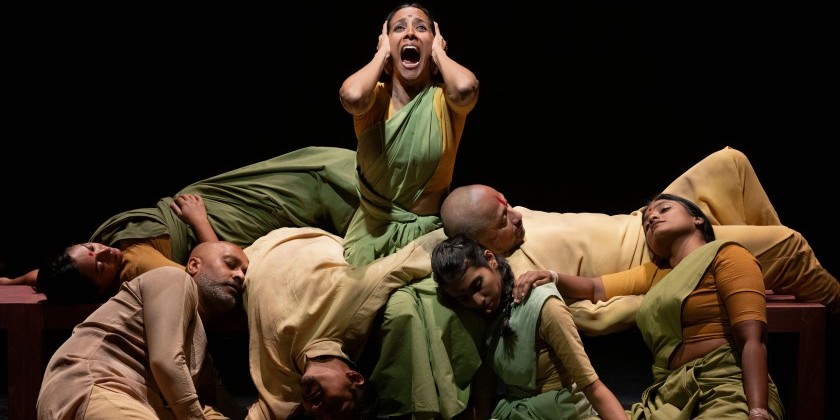IMPRESSIONS: "Curriculum II" by Bill T. Jones/Arnie Zane Company Makes NYC Premiere at New York Live Arts

Conceived and Directed by Bill T. Jones
Choreography by Bill T. Jones with Janet Wong and the Company
Lighting Design by Robert Wierzel
Video Design by Janet Wong
Sound Design by David van Tieghem
Installation and Costume Design by Liz Prince
Text adapted from: Louis Chude-Sokei The Sound of Culture: Diaspora and Black Technopoetics; Mark O’Connell Uncanny Planet: William Shakespeare The Tempest; The Bible Genesis 1:28-31
The Company: Barrington Hinds, Jada Jenai, Shane Larson, s.lumbert, Danielle Marshall, Marie Lloyd Paspe, Jacoby Pruitt, Nayaa Opong, Philip Strom, Huiwang Zhang
January 11, 2023
Down a corridor draped in plastic sheets smeared with blood-red paint, above a floor that reads “don’t tread on me,” and through a forest of small black dolls hanging from nooses, a world emerges — a dystopian world caught between past and future. Computer monitors wedge between seats as if fallen there after an explosion. The phrase “Call it Culture” floats across them in eerie refrain. Stripped bare of wings and curtains, the skeletal structure of New York Live Arts is exposed- creating a strangely new, yet familiar, landscape. Conceived and directed by Bill T. Jones, with choreography by Jones and Janet Wong, Curriculum II addresses the meaning of global citizenship and the cultural effects of technology, asking us to examine our navigation of history in light of our present experience.

Any worthwhile curriculum is carefully designed to generate proficiency, but isn't necessarily an end in itself, rather a vehicle. Think of Curriculum II as a Ferrari. The many ideas swirling around Jones’ New York City premiere move fast, taking us on one wild ride! Concepts are not consecutive, and with seating in the round and each spectator given a different view of Liz Prince’s eerie installations, proficiency is not promised. As all good teachers do, Jones calls us to join him and his dancers in an ongoing inquiry, and bring an open mind.

The dancers, initially sitting among the audience, rise and begin spinning in the dark holding cell phones with flashlights on. Performer Marie Lloyd Paspe sings in a strong, radiant voice: “Streets full of people, all alone; roads full of houses, never home.” The dancers circle their arms as if holding invisible partners, their tiny flashlights orbiting like stars. Here, humanity’s most ubiquitous piece of technology poignantly transforms the stage into genesis.

The movement, created in collaboration with the dancers, is gestural and specific, offering a visual anchor to this turbulent and complex work. Deliberate, committed, marvelously individual, the performers master sudden balances and precipitous turns with ease and bring structure to the space with precise walking patterns. The choreography powerfully guides viewers through the maelstrom of words, music, and floating images, securing them in the present.

Sound designer, David van Tieghem, arranges text pieces to coax understanding rather than dictate it. Culling passages from Cameroonian historian Achille Mbembe, Jean-Paul Sarte, Jamaican writer, Sylvia Wynter and Nigerian scholar, Louis Chude-Sokei, Curriculum II explores the connections between race and technology as well as posing questions about the future.

Curriculum II; photo by Maria Baranova and courtesy of New York Live Arts
Dancer Shane Larson, who also serves as the narrator, recites Sarte: “Blacks have clearly functioned as both (slaves and monsters.) But so have machines.” He performs a duet with Nayaa Opong in which they mirror each other from a distance, methodic and never touching.
Dancers rush to displace each other in a rotating cluster, the panic of not having enough resources in a changing environment breeding aggression. Snippets of the Bible can be heard: “Be fruitful, and multiply, and replenish the earth, and subdue it, and have dominion over every living thing.” Yet how do we both replenish the earth and have dominion over it?

As we create new technology to improve our quality of life and productivity- artificial intelligence, robotics, and nano technology- will the machinery we have authority over today evolve to control us tomorrow? Have humans taken this ancient directive to an extreme, subjugating, exploiting and overpowering one another in a quest for purpose? Jones guides us through these questions as a teaching tool for both himself and his audience, an emerging sense of warning deeply sensed.

Disparate verses and images begin to come more quickly. Performers climb onto platforms within the audience and roll their bodies with paint. Opong, covered in silver, vacillates between robotic precision and animalistic rage. Philip Strom performs vulgar, sexualized gestures and Nazi-esque heel clicks with tattered strips of American flag tied around his arms and legs. His grounded stomps and swirling costume give impressions of Native American dance, a clear metaphor for the machine of greed and conquest that once claimed the very land Strom is dancing on. “Yesterday’s monsters are today’s subjects,” Larson says. “Today’s machines are tomorrow’s human beings.”
Curriculum II is dark, but with shards of light. “The other must be understood as that which is to come,” Larson says. As Papse reprises her song from the opening, the dancers circle again, this time closer together, as one. They turn to face the audience, calling us to actively participate in this new world we are creating moment by moment, learning from the past.












